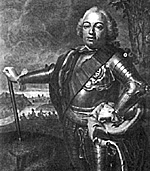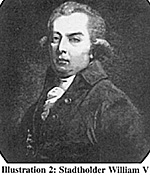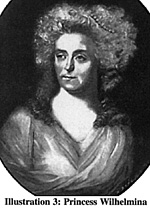 The Dutch During
The Dutch During
The Revolutionary Wars
Prussian Campaign
in Holland 1787
Part I
Introduction and Preparations
by Geert van Uythoven, The Netherlands
| |
Introduction and PreparationsOn of the most obscure campaigns of the revolutionary and Napoleonic wars is the Prussian campaign in Holland, 1787. Nevertheless, it is a very interesting campaign, both for historians and wargamers. Participating in this campaign were many Prussian officers, that later would make a name for themselves: Massenbach, Müffling, York, Blücher, and Zieten, to name but a few. The campaign saw many small actions, useful for wargamers, especially for skirmishing games. Moreover, the campaign renders much, much more. See for yourself! The Republic of the United Provinces [1] was a late participant in the fight against revolutionary France. However, on 1 February 1793 Revolutionary France declared war both to the stadtholder of the Dutch Republic and the King of England. In January 1795, the Dutch Republic ceased to exist, and the Batavian Republic, satellite of France, was created. To understand how it is possible that revolutionary France defeated the once so powerful Dutch Republic, it is necessary to look at what happened in the years before, and how the situation that existed at the end of the 18th century could arise. Keep in mind that what I will tell is only a very simplified version of what happened, just enough to understand what occurred during the revolutionary wars, and to understand the 'relation' between the French and Dutch.
Many see the American and French revolutions as the cradle of democracy, but in fact they were proceeded by the rising of the Low Countries against their lawful King, Philip II of Spain (1555-1598). Philip II became King of Spain and her colonies, and of the Netherlands (roughly nowadays Belgium and the Netherlands). During his reign, the Dutch became very discontented, mainly about the fact that the Dutch had less and less influence in politics, the presence of Spanish troops in the Netherlands (because of the war with France), and the brutal persecution of heretics by the Spanish Inquisition, and, last but not least, taxes. Resistance started with the higher nobility, and was taken over by the lower nobility and later the common people. The tension culminated in 1566 in the 'beeldenstorm', the plundering of catholic churches.
The answer of Philip II was the dispatch of the Duke of Alba with 10,000 Spanish soldiers. The rebelling inhabitants reacted by forming small armies, but Dutch government forces subdued these. From 1568 on the rebellion gathered pace, with military resistance concentrating around William 'the Silent', Count of Nassau, Prince of Orange. The war against Spain lasted eighty years. Only in 1648, the separation was formalised by the Peace of Munster (Peace of Westphalia): seven Dutch provinces formed a republic. The southern provinces of the Netherlands, roughly nowadays Belgium, remained Spanish. An article of the treaty effected the closing of the river Scheldt to all shipping. This was very important for the Dutch, because otherwise Antwerp would become a serious competitor for Amsterdam. This fact would cause trouble for many years to come.
The Republic consisted of seven independent provinces, each governed by its own States. They had allied themselves by the Union of Utrecht (1579), which was principally an agreement of military co-operation. Holland was the most important and powerful province, with Amsterdam as the most important city. The province Holland paid 58% of the expenses of the Republic, so its influence was huge. In most cases, commercial interest was decisive. The composition of the States and thereby the amount of votes differed:
The provinces had each one vote in the States General, sited at The Hague in the province Holland, which took care of all joint cases. There were also three so-called 'generaliteitslanden', the province Brabant, Limburg, and Zeeuws Vlaanderen. These were treated as conquered territories, and were governed directly by the States General.
The stadtholder served the States of the provinces, so theoretically there could be seven at the same time. In reality, after 1600 there were no more than two stadtholders, and from 1747 only one. [2]
The States of a province chose a stadtholder, but they always choose one out of the House of Nassau, so practically the position was hereditary to this House. The stadtholder was Captain-General of the army, and Admiral-General of the fleet. In this role he had to report to the States General and these took the important decisions. Most of the time, the States General attached representatives to the field army, to watch over the actions of the stadtholder. [3] In addition, the stadtholder appointed the municipalities of the cities.
The army of the Dutch Republic consisted of mercenaries. In particular many Germans served in the Dutch army, but there were also complete foreign Swiss and English battalions. In fact, there was no Dutch army, because every province had its own army, and without approval of the States, these troops could not be used outside its own province. Only five provinces [4] participated in the fleet, and these had their own Admirals.
Relations between the stadtholder and the States General were difficult. As one can see from the balance of votes in the States, the cities had most of the power, but this did not mean that there was common democracy. Power was with the regents, the wealthy merchants, and these took the decisions, always taking good care of their own personal commercial interests. The one thing they were afraid of was a stadtholder with too much power. Further, a stadtholder was a very useful scapegoat if things went wrong.
Also, there was always discussion about who had more power: the States General or the States of the separate provinces. The stadtholder advocated a strong central government, to conduct strong foreign politics. The regents tried to prevent this, because they were afraid of their commercial interests. So two parties arose: the 'Pro-States', consisting of the regents, and the 'Orangists', consisting of the nobility and common people.
Stadtholder William III became in 1688 King of England. The regents used his absence to strengthen their own power. When William III died in 1702 without any children, the States decided to appoint no stadtholder in his place. Up to 1747, there was no stadtholder in the Dutch Republic. During this period government was bad, and the regents considered power as their own property; government and common people grew apart.
In 1747, the French invaded the south of the Dutch Republic. The country was panicking, and the common people wanted an Orange back as stadtholder. The regents became afraid of the popular movement, and quickly appointed stadtholder William IV, count of Nassau, Prince of Orange. However, William IV was a weak personality, and he did nothing to change things, disappointing his followers. Soon the regents noticed that they still were in power, and fell back in their old habits. However, the world was changing…
Beside the common people, also the wealthy citizens had no influence on (local) politics. These were educated people, and were now influenced by the ideas of men of their time, such as Voltaire and Locke. At first, these citizens hoped that William IV would change things, but now it was clear they could not count on him –if it was possible to change things at all! So beside the 'Pro-States' and 'Orangists' a third party arose: the 'Patriots'.
William IV died in 1751, leaving a three-year-old son. Because the position of stadtholder was now hereditary, the widow of William IV, Princess Anna of England, was installed as 'governance'. Because she was English and had no understanding of Dutch and Dutch politics, the regents again met no resistance. When she died in 1759 the Prince was still under age, and now a 'guardian' was installed: the German Duke Ernst von Braunschweich-Wolfenbüttel, at that moment serving in the Dutch army. As a guardian, he had no real power, but behind the curtains he managed to make himself indispensable, as well with the young hereditary stadtholder as well as with the regents.
In 1766, the hereditary stadtholder William V was declared of age, but he was also a weak personality. He was strongly influenced by the Duke of Brunswick (William V promised to do nothing without his approval) and his wife, the Prussian Frederika Sophia Wilhelmina von Hohenzollern, sister of the future King of Prussia, who we will meet again. Again, the regents ruled without opposition. However, the patriots did not like the situation at all. They opposed the Duke of Brunswick, who they said had a bad influence on William V. The Dutch Republic found itself at war with England, lasting till 1784. Overseas trade was impossible, and the merchant's losses were enormously. The Duke of Brunswick was blamed, and the patriots acted so strongly against him that he left the Dutch Republic.
The patriots were in high spirits because of this victory. Now they blamed William V for everything. More dangerous, they started to arm themselves, and formed their own armies, called 'exercitieg-enootschappen' (Free Corps'). It was said that the Free Corps' [5] were created against the threat of the Austrian Emperor Josef II [6], but in reality, they were created as a protection against the army, and as a counterpoise against the militia, which were in general Orangists. Especially in the province Holland, the patriots had much influence. The patriots and regents competed in getting as many followers as possible.
During 1784, the patriots became more daring. The Free Corps' were the cause of many riots, especially in the city Utrecht, all in the name of freedom and justice. More and more cities refused to take into their municipality people who were appointed by the stadtholder. At last, the situation escalated. On 4 September 1785, a member of the exercitiegenootschap of the city Leiden called Harteveld was, in his uniform with the black cockade, insulted in the presence of some of his friends. A riot resulted, and the States of Holland ordered that the garrison of The Hague had to patrol the streets in the future, to prevent the same thing happening in their city. The stadtholder William V judged that he was the only one who had the right, in his function as Captain-General, to give orders of this kind to the garrison. However, the States again gave the same order to the garrison. William V, by this act practically removed from his 'command' in The Hague, decided to leave, and finally removed his court to the city Nijmegen.
The insult done to his son-in-law caused the Prussian King to protest [7], but the States of Holland ignored it completely. The patriots smelled victory, and everything that reminded of Orange had to be removed. Wearing orange was forbidden. Crying 'Hoezee' was high treason. A grocer was flogged because he wrapped something in orange paper. However, in other cities the Orangists still had the upper hand, and the situation was very confusing, with many riots. Only in the provinces Friesland, Gelre, and Zeeland the States were still on the side of the stadtholder, in the other provinces the patriots had the upper hand.
Then something else happened. Two cities, Hattem and Elburg in the province Gelre, were openly patriotic, and gathering places of patriots from the whole province. On 21 August 1786, the States of Gelre ordered the stadtholder, in his quality as Captain-General of the army, to send troops to these cities to 'restore order'. In Hattem, the patriots, led by Herman Willem Daendels [8], received news of this act, and were busy strengthening the defences. Members of the Free Corps of other cities reinforced them. Daendels even managed to obtain from the city Zwolle some guns with ammunition. The task of restoring order in Hattem was given to Major General Spengler. His force consisted of the infantry regiments 'Plettenberg' and 'Sommerlatte', a cavalry troop from the Regiment 'Tuill van Serooskerken' and an artillery detachment. After some skirmishing these troops stormed the gate and took Hattem without loss, most of the patriots having already taken flight.
After taking the city, the troops started plundering, and it took some time before their officers could restore order. Everywhere the patriots called out for revenge. Although the stadtholder only followed his orders, the patriots called him a tyrant and an oppressor. On 22 September, the States of Holland removed him from his position as Captain-general, and formed a defensive army corps commanded by the Rheingraf von Salm. He was ordered to protect the provinces Holland and Utrecht. In addition, the patriots believed that they could count on support from France, because of the defensive alliance that existed (see note 5).
In the province Utrecht, the people were divided. Part of the States of Utrecht had moved to the city Amersfoort, were they still kept in close contact with William V, while most cities sided with the patriots. During May 1787, the patriots received news that the States residing at Amersfoort had sent for troops from the province Gelre. The patriots decided to advance on them with about 300 members of the Free Corps of the city Utrecht. Near the village Vreeswijk, they clashed, and the troops from Gelre took flight. Nevertheless a few patriots were killed and became martyrs, and again the stadtholder took the blame. The States of Holland acted by sending their own troops to Utrecht. The Dutch Republic was at the brink of civil war.
Now the patriots made a mistake. The wife of William V was, as we already saw, the Prussian Wilhelmina von Hohenzollern, sister of the now Prussian King Friedrich Wilhelm III. Princess Wilhelmina wanted to try to save the nation in person, and, only accompanied by some servants, moved from Nijmegen to The Hague. On 28 June 1787 the patriots at Goe-Jan-Verwellen-Sluis, near the border of the province Holland, stopped her, and refused passage. In addition, the patriots insulted her. The States of Holland approved the action, but the States of the provinces Gelre, Zeeland, Utrecht, and Friesland condemned it. When the King of Prussia received news of the insults done to his sister, he demanded satisfaction, and punishment for the guilty ones. However, the patriots felt themselves safe, with their Free Corps, militia, and the field army commanded by the Rheingraf von Salm. The city Gorkum, the key of Holland, was strongly fortified. The city Utrecht was unassailable. In addition, in case of a Prussian attack the patriots counted on French support. The scene was set for a confrontation between the patriots and Prussia.
More Prussian Campaign in Holland 1787 Part I
The Dutch During the Revolutionary Wars
|
 At right: Illustration 1: Stadtholder William IV
At right: Illustration 1: Stadtholder William IV
 At right: Illustration 2: Stadtholder William V
At right: Illustration 2: Stadtholder William V
 At right: Illustration 3: Princess Wilhelmina
At right: Illustration 3: Princess Wilhelmina